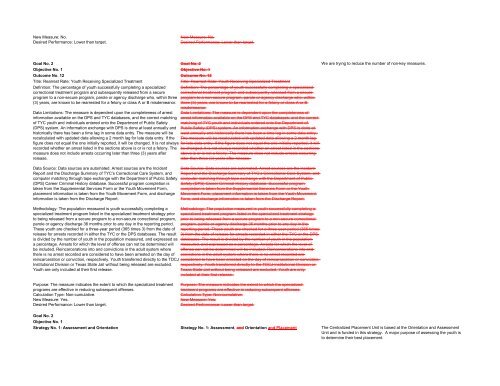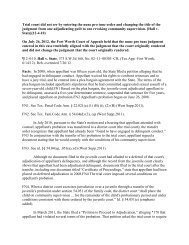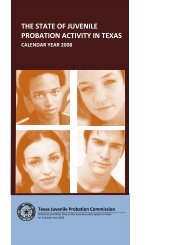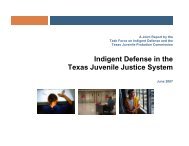(TJJD) Office of Inspector General - Texas Juvenile Justice Department
(TJJD) Office of Inspector General - Texas Juvenile Justice Department
(TJJD) Office of Inspector General - Texas Juvenile Justice Department
You also want an ePaper? Increase the reach of your titles
YUMPU automatically turns print PDFs into web optimized ePapers that Google loves.
New Measure: No.Desired Performance: Lower than target.New Measure: No.Desired Performance: Lower than target.Goal No. 2 Goal No. 2 We are trying to reduce the number <strong>of</strong> non-key measures.Objective No. 1 Objective No. 1Outcome No. 12 Outcome No. 12Title: Rearrest Rate: Youth Receiving Specialized TreatmentTitle: Rearrest Rate: Youth Receiving Specialized TreatmentDefinition: The percentage <strong>of</strong> youth successfully completing a specializedcorrectional treatment program and subsequently released from a secureprogram to a non-secure program, parole or agency discharge who, within three(3) years, are known to be rearrested for a felony or class A or B misdemeanor.Definition: The percentage <strong>of</strong> youth successfully completing a specializedcorrectional treatment program and subsequently released from a secureprogram to a non-secure program, parole or agency discharge who, withinthree (3) years, are known to be rearrested for a felony or class A or Bmisdemeanor.Data Limitations: The measure is dependent upon the completeness <strong>of</strong> arrest Data Limitations: The measure is dependent upon the completeness <strong>of</strong>information available on the DPS and TYC databases, and the correct matching arrest information available on the DPS and TYC databases, and the correct<strong>of</strong> TYC youth and individuals entered onto the <strong>Department</strong> <strong>of</strong> Public Safety matching <strong>of</strong> TYC youth and individuals entered onto the <strong>Department</strong> <strong>of</strong>(DPS) system. An information exchange with DPS is done at least annually and Public Safety (DPS) system. An information exchange with DPS is done athistorically there has been a time lag in some data entry. The measure will be least annually and historically there has been a time lag in some data entry.recalculated with updated data allowing a 2 month lag for late data entry. If the The measure will be recalculated with updated data allowing a 2 month lagfigure does not equal the one initially reported, it will be changed. It is not always for late data entry. If the figure does not equal the one initially reported, it willrecorded whether an arrest listed in the sections above is or is not a felony. The be changed. It is not always recorded whether an arrest listed in the sectionsmeasure does not include arrests occurring later than three (3) years after above is or is not a felony. The measure does not include arrests occurringrelease.later than three (3) years after release.Data Source: Data sources are automated. Arrest sources are the IncidentReport and the Discharge Summary <strong>of</strong> TYC’s Correctional Care System, andcomputer matching through tape exchange with the <strong>Department</strong> <strong>of</strong> Public Safety(DPS) Career Criminal History database. Successful program completion istaken from the Supplemental Services Form or the Youth Movement Form,placement information is taken from the Youth Movement Form, and dischargeinformation is taken from the Discharge Report.Methodology: The population measured is youth successfully completing aspecialized treatment program listed in the specialized treatment strategy priorto being released from a secure program to a non-secure correctional program,parole or agency discharge 36 months prior to any day in the reporting period.These youth are checked for a three-year period (365 times 3) from the date <strong>of</strong>release for arrests recorded in either the TYC or the DPS databases. The resultis divided by the number <strong>of</strong> youth in the population measured, and expressed asa percentage. Arrests for which the level <strong>of</strong> <strong>of</strong>fense can not be determined willbe included. Reincarcerations into and convictions in the adult system wherethere is no arrest recorded are considered to have been arrested on the day <strong>of</strong>Data Source: Data sources are automated. Arrest sources are the IncidentReport and the Discharge Summary <strong>of</strong> TYC’s Correctional Care System, andcomputer matching through tape exchange with the <strong>Department</strong> <strong>of</strong> PublicSafety (DPS) Career Criminal History database. Successful programcompletion is taken from the Supplemental Services Form or the YouthMovement Form, placement information is taken from the Youth MovementForm, and discharge information is taken from the Discharge Report.Methodology: The population measured is youth successfully completing aspecialized treatment program listed in the specialized treatment strategyprior to being released from a secure program to a non-secure correctionalprogram, parole or agency discharge 36 months prior to any day in thereporting period. These youth are checked for a three-year period (365 times3) from the date <strong>of</strong> release for arrests recorded in either the TYC or the DPSdatabases. The result is divided by the number <strong>of</strong> youth in the populationmeasured, and expressed as a percentage. Arrests for which the level <strong>of</strong><strong>of</strong>fense can not be determined will be included. Reincarcerations into andconvictions in the adult system where there is no arrest recorded arereincarceration or conviction, respectively. Youth transferred directly to the TDCJ-considered to have been arrested on the day <strong>of</strong> reincarceration or conviction,Institutional Division or <strong>Texas</strong> State Jail without being released are excluded. respectively. Youth transferred directly to the TDCJ-Institutional Division orYouth are only included at their first release.<strong>Texas</strong> State Jail without being released are excluded. Youth are onlyincluded at their first release.Purpose: The measure indicates the extent to which the specialized treatmentprograms are effective in reducing subsequent <strong>of</strong>fenses.Calculation Type: Non-cumulative.New Measure: Yes.Desired Performance: Lower than target.Purpose: The measure indicates the extent to which the specializedtreatment programs are effective in reducing subsequent <strong>of</strong>fenses.Calculation Type: Non-cumulative.New Measure: Yes.Desired Performance: Lower than target.Goal No. 2Objective No. 1Strategy No. 1: Assessment and Orientation Strategy No. 1: Assessment, and Orientation and Placement The Centralized Placement Unit is based at the Orientation and AssessmentUnit and is funded in this strategy. A major purpose <strong>of</strong> assessing the youth isto determine their best placement.
















